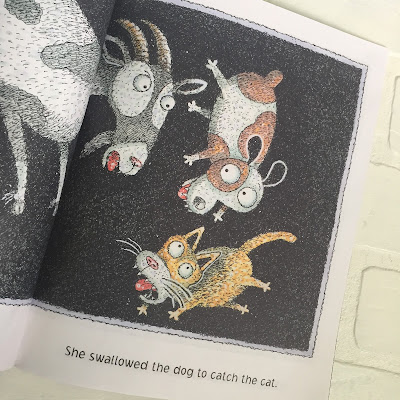I absolutely love using books in therapy. It doesn’t matter
if I am working on articulation, vocabulary or fluency, I will find a way to work
a book into the session. After years of
group therapy while working in the schools, I believe I have perfected the skill of
working just about any goal into a lesson with a book. Below is an example of how I have done this with
one of our most beloved books, There Was an Old Lady Who Swallowed a Fly by Lucille Colandro. I
would love to hear how you use books in therapy, too!
This post contains Amazon Affiliate links for your convenience. This means if you purchase something from the links provided, I may make a small commission.
Articulation:
Yes! You can use books with your articulation students. Go on a word hunt! Search for words that contain your
student(s) target sound and make a list! If your students are older and are readers,
have them read the book aloud to the group while they work on carrying over
their good speech sounds as they read.
One of my favorite ways to use books in therapy is to read the story aloud and purposefully mispronounce words that has the child's speech sounds in them. This is a great auditory discrimination activity and the looks they will give you when you say a word wrong are priceless!
One of my favorite ways to use books in therapy is to read the story aloud and purposefully mispronounce words that has the child's speech sounds in them. This is a great auditory discrimination activity and the looks they will give you when you say a word wrong are priceless!
Part Whole Relationships:
Picture books can be the perfect tools to use to work on part whole relationship questions!
“Where is the lady’s hat?”
“Where is the cat’s nose?”
“Where are the dog’s eyes?”

Yes/No Questions:
Working on yes/no questions can be really fun. When you (the adult) make a mistake, kids always find it hilarious. On the page pictured above, the lady
swallowed a cat. But read the story as, “There was an old lady who swallowed
an elephant! Is this an elephant?” You will most likely get a giggle and a “Noooooo!
That’s a cat!”
Retelling/Sequencing
These Old Lady books are fabulous for retelling and story sequencing.
Use visuals and have your kids retell the order of events for the story.
Predicting:
Guess what she will swallow next! Take it a step
further and ask why?
Fluency:
Read the story aloud to your students. Read some pages with smooth speech and other pages with "bumpy" dysfluent speech. Have your students raise their hand when they hear "bumpy" speech or tell you if you are using your good fluent speech techniques!
Memory Skills:
Randomly close the book and have your student recall all the
animals that he/she remembers seeing in the book so far.
Attributes:
On the page below, all of the animals are pictured. Ask your student(s) questions about defining characteristics of the animals. For example:
"Which animal has wings?"
"Which animal has soft fur?"
"Which animal has pointed ears?"
"Which animal is the biggest?"
Pronouns:
Talk about each picture using pronouns to correctly describe what happened. (I like to use a visual sentence strip to help my younger students with this.)
"She swallowed a cow!"
"The cow is bigger than her!"
And these ideas are just the tip of the iceberg! I really love using the Old Lady series books in therapy because there is one for just about every season/theme. You can check all of them out on amazon, here. But so many books work just as well for hitting multiple goals, not just this one.
A huge benefit to using one book to touch on all, if not most, of your caseload's goals is that it reduces your baggage. Since I no longer have a classroom and travel to each of my students, the lighter the load, the better!
Have more ideas of goals to hit with this book? Share with everyone below in the comments!



























